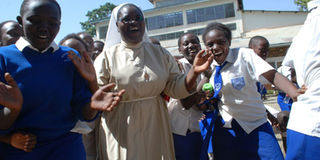More score 'A' compared with 2013 exam

Sister Anne Josephine Apiyo and students of Asumbi girls High school in Homabay county celebrate in their school on March 03, 2015 immediately after the release of the 2014 KCSE results. The school has shown an exemplary performance in the region with mean of 10.75. PHOTO | CORRESPONDENT | NATION MEDIA GROUP
What you need to know:
- Performance by gender showed that 88,299 (59 per cent) male and 61,418 (41 per cent) female candidates attained an overall mean grade of C+ and above.
- Candidates sitting for the examination had increased, said Prof Kaimenyi, given that 483,630 candidates sat for the examination, representing an increase of 36,934 candidates which translates to an 8.3 per cent increase compared to the 446,696 candidates who sat the examination in 2013.
- Prof Kaimenyi said 259,746 male candidates and 223,884 female candidates sat for the 2014 examination, representing a national gender ratio of 54 per cent boys: 46 per cent girls.
More than 3,073 candidates scored an overall mean grade of A in the 2014 Kenya Certificate of Secondary Education examination that was released on Tuesday.
This was an increase from 2,722 candidates in 2013.
“Overall mean grade of A by gender shows that 2,133 male candidates (69.4 per cent) and 940 female candidates (30.6 per cent) attained this highest possible grade,” said Education Cabinet Secretary Jacob Kaimenyi when he released the results at Mitihani House in Nairobi.
About 11,768 candidates scored an A- , 19,814 scored B+, 29,319 scored B, 38,315 scored B-, 47,428 candidates scored C+, and 58,688 scored C.
Another 70,677 candidates scored C-, 76,198 scored D+ with 73,501 scoring D, 47,716 D- and 5,636 E.
Those who scored E in 2013 were 7,042.
About 149,717 candidates attained the minimum university entry qualification of C+ compared to 123,365 candidates in 2013.
OVERALL MEAN GRADE
Performance by gender showed that 88,299 (59 per cent) male and 61,418 (41 per cent) female candidates attained an overall mean grade of C+ and above.
Prof Kaimenyi said the result was for candidates who enrolled in Standard One in 2003 and Form One in 2011 and were the first beneficiaries of Free Primary Education and Free Secondary Education.
“This is, therefore, a realisation of the government’s vision to increase the number of children accessing a full cycle of primary and secondary education,” said the Cabinet secretary.
However, he admitted that the dropout rate of students in secondary school remains a challenge.
“During the year 2011, when the 2014 KCSE examination cohort joined Form 1, a total of 521,601 students were admitted into our secondary schools. Out of these, 483,630 sat for the KCSE examination in the 2014, representing an overall wastage of 7.85 per cent,” said Prof Kaimenyi.
This was of great concern to the ministry given the huge resources that the government had invested in secondary school education, he said.
FIRST FPE BENEFICIARIES
Candidates sitting for the examination had increased, said Prof Kaimenyi, given that 483,630 candidates sat for the examination, representing an increase of 36,934 candidates which translates to an 8.3 per cent increase compared to the 446,696 candidates who sat the examination in 2013.
“This increase in candidature is the highest in the last three years and is attributed to the fact that, as earlier said, the cohort of candidates consists of the first beneficiaries of the Free Primary Education and Free Secondary Education, which came into effect in 2003 and 2011 respectively,” he said.
Prof Kaimenyi said 259,746 male candidates and 223,884 female candidates sat for the 2014 examination, representing a national gender ratio of 54 per cent boys: 46 per cent girls.
“This is comparable to the 2013 examination when a gender ratio of 55 per cent boys: 45 per cent girls was recorded,” said the CS.
FEMALE CANDIDATES
However, he noted that despite the number of male candidates who sat for the examination being higher than that of female candidates since the inception of the examination, candidature trends indicate that the percentage increase of female candidates has been higher than that of male candidates in the past three years, with the highest percentage increase in the number of female candidates standing at 10.3 per cent recorded in 2014 examination compared to the 6.6 per cent increase of male candidates in the same year.
He said that there was an increase in candidature in all 47 counties during the examination, with the exception of Lamu and Nyamira counties, which recorded a decline in candidature in 2014 compared to 2013.
“Just as was the case during the 2013 examination, Kiambu, Nakuru, Kakamega and Nairobi counties had the highest number of candidates sitting for the 2014 examination,” added Prof Kaimenyi.
He attributed this to large areas of land covered by the counties and the high density of population in the major towns in the counties.
The CS said eight counties had more female than male candidates, compared to 18 counties in the 2013 examination.
They are Taita Taveta, Nyandarua, Nyeri, Kirinyaga, Murang’a, Kiambu, Meru and Tharaka Nithi counties.





